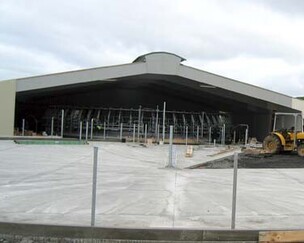About Limestone Downs
AN ATTRACTIVE 3,219 HECTARE (7,954 ACRES) PROPERTY.
Limestone Downs is a large sheep, beef and dairy property situated 15 kilometres south of Port Waikato.
GENERAL MANAGER
Paul Mahoney
The Landscapes of Limestone Downs
Limestone Downs consists of a 320-hectare dairy platform, 400 hectares of native bush, now fenced off for regeneration and future preservation; a small area of forestry, with the balance being used for sheep and beef production. It has a good balance of hills and flats, with a wide range of soils varying from peat to volcanic in origin, and a favourable climate.
History of Limestone Downs
Limestone Downs, a property of 3,219 hectares (7,954 acres) lies on the coast between the Waikawau and Kaawa Streams, extending inland to the Te Akau Line.
Read more on the history of the property below or grab a copy of Barrie Macdonald's Imperial Patriot: Charles Alma Baker and the History of Limestone Downs (1993).
Pre-WWII
Post WWII
Limestone Downs Development
Pre-WWII
When the property was purchased by Charles Alma Baker in 1926, more than a third of the land was still in virgin bush and little of the development to that stage had been well-planned or executed. The pasture had mostly been lost to the depredations of rabbits and had reverted to weeds. The greatest potential lay in some 200 hectares of swamp country to the south of the farm.
There was no direct road access and, for much of the year, the farm was only accessible on horse or by foot. There were few fences, with many of the paddocks being more effectively divided by stands of bush than by fences.
In addition to the purchase price of £30,600, Baker made a heavy investment in bush clearance, fencing, and the draining of the swamp. Within three years, sheep numbers on the property had been increased from 1,800 to 9,000. Baker continued a brisk pace of development despite the Depression of the late 1920s and early 1930s. By 1935, sheep numbers were over 12,000. By the mid-1930s, Baker had invested more than £100,000 in addition to the purchase price; the property carried a mortgage of £40,000 with the balance being covered by capital transfers from Malaya.
Post-WWII
After the Second World War, Limestone Downs languished, as Baker’s trustees considered the future of his estate, grappled with the problems posed by death duties and wartime shortages, and lived with the threat of a forced sale to government and the subdivision of Limestone Downs for ‘Rehab’ – the re-settlement of soldiers on the land. By the 1950s, however, there was more optimism with wool prices boosted by the Korean War, debts cleared, successful experiments with aerial topdressing and, in Malaya, a rubber boom that contributed some of the capital needed at Limestone Downs.
The impetus for accelerated development was carried on by Dan O’Connell who was appointed Manager at Limestone Downs in 1950. O’Connell remained until 1973, during which time second-growth bush and scrub was cleared, ‘the swamp’ (now ‘the flats’), were re-developed with heavy earth-working machinery renewing and extending the network of drains; in addition, all fences were replaced, and a new wool shed and yards built together with a new manager’s house. The farm could now winter 12-13,000 sheep and 1,200 cattle.
Limestone Downs Development
The establishment of the C Alma Baker Charitable Trust in 1981 and the involvement of Massey University in the farm's management saw the philosophical basis of the farm’s management radically altered.
Rather than being regarded as a ‘station’ run by extensive farming methods, Limestone Downs was to be farmed intensively. The emphasis was now upon subdivision using electric fencing, smaller paddocks, smaller flocks and herds, rotational grazing and higher-performing livestock.
To achieve this level of change, stock were assessed and culled on performance, new breeding programmes were established for sheep and cattle, and the farm was an early promoter of a bull-beef initiative using weaner calves from the dairy industry.
Vehicle access on the farm was improved, fertiliser needs assessed, and a new water reticulation scheme was constructed.
By the early 1990s, the value of the property as a going concern had been improved by 73 per cent in a decade.
Under optimum conditions, Limestone Downs could now carry 35-36,000 stock units. Over the next decade, sheep numbers halved while cattle numbers doubled.
Under the difficult market conditions of the mid-1990s, returns dropped sharply, and the balance of sheep to beef again shifted. An experimental sheep cross-breeding programme was initiated to ascertain whether breeds other than the traditional Romney might be found more suitable for the conditions at Limestone Downs.
These developments, and price trends, led to more emphasis on selling lambs for slaughter rather than store, and a decision to meet all cattle requirements through the purchase of calves (bulls or steers) rather than maintaining breeding cows on Limestone Downs as part of a large dairy beef operation.
Following reviews of soil fertility on the farm, fertiliser was applied significantly above maintenance levels for several years, together with a strategic application of nitrogen at critical times of the year to optimise pasture growth.
Improved market conditions allowed the Trust to embark on an ambitious pasture improvement programme over 2012-2013, including the humping and hollowing of a significant area of the coastal flats for the first time in fifty years.
This became the basis of a dairy conversion with a 300 ha milking platform and rotary dairy shed that was commissioned in 2013.
The dairy enterprise, with a milking herd of about 700 cows now operates alongside the substantial sheep and beef operation.















